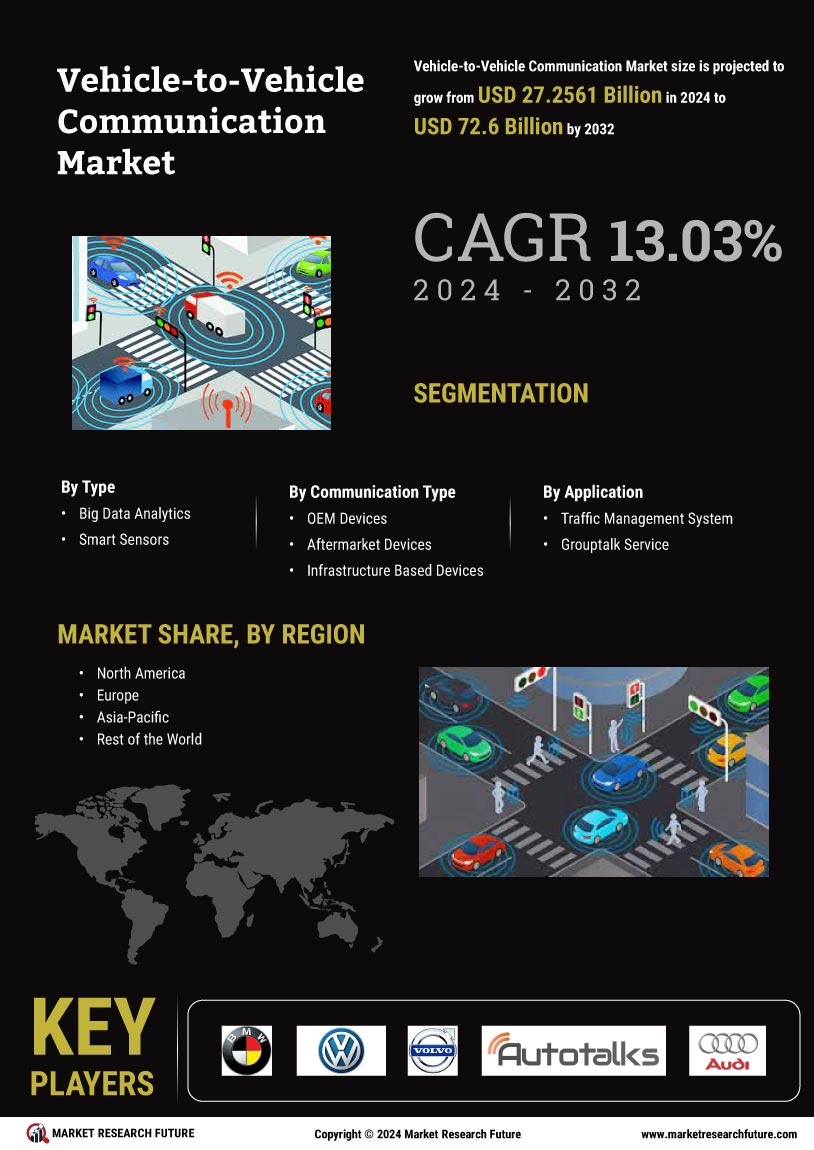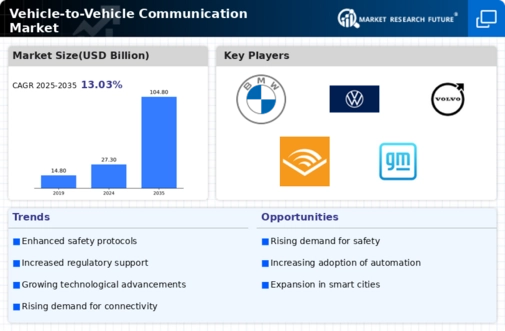Smart City Initiatives
The Global Vehicle-to-Vehicle Communication Market Industry is also shaped by the proliferation of smart city initiatives worldwide. Urban planners are increasingly incorporating V2V communication technologies into their infrastructure to enhance traffic management and reduce congestion. For instance, cities like Barcelona and Singapore are implementing smart traffic systems that utilize V2V communication to optimize traffic flow and improve public safety. This trend is likely to contribute to the market's growth, as municipalities recognize the potential of V2V communication to create more efficient and sustainable urban environments.
Market Growth Projections
The Global Vehicle-to-Vehicle Communication Market Industry is projected to experience robust growth in the coming years. The market is anticipated to reach 27.3 USD Billion by 2024, with a remarkable increase to 104.8 USD Billion by 2035. This growth trajectory indicates a compound annual growth rate (CAGR) of 13.03% from 2025 to 2035, reflecting the increasing adoption of V2V communication technologies across various regions. Factors contributing to this growth include technological advancements, regulatory support, and rising consumer demand for enhanced vehicle safety and connectivity.
Increasing Focus on Road Safety
The Global Vehicle-to-Vehicle Communication Market Industry is increasingly influenced by a heightened focus on road safety. Governments and regulatory bodies are advocating for the adoption of V2V communication systems to reduce traffic accidents and fatalities. For example, the European Union has set ambitious targets to decrease road fatalities by 50% by 2030, which aligns with the deployment of V2V technologies. This regulatory push is likely to drive market growth, as the industry anticipates a surge in demand for safety-enhancing communication solutions, contributing to an estimated market value of 104.8 USD Billion by 2035.
Consumer Awareness and Acceptance
The Global Vehicle-to-Vehicle Communication Market Industry is witnessing a shift in consumer awareness and acceptance regarding advanced vehicle technologies. As consumers become more informed about the benefits of V2V communication, such as improved safety and convenience, there is a growing demand for vehicles equipped with these systems. Manufacturers are responding by integrating V2V capabilities into their new models, thereby enhancing their market competitiveness. This trend is expected to further stimulate market growth, as consumer preferences increasingly favor vehicles that offer advanced communication features.
Rising Demand for Autonomous Vehicles
The Global Vehicle-to-Vehicle Communication Market Industry is significantly impacted by the rising demand for autonomous vehicles. As manufacturers invest heavily in developing self-driving technologies, V2V communication becomes essential for enabling vehicles to interact with each other and their environment. This interaction is crucial for the safe operation of autonomous systems, as it allows vehicles to share critical information such as speed, direction, and potential hazards. The market is expected to grow at a CAGR of 13.03% from 2025 to 2035, driven by the increasing integration of V2V communication in autonomous vehicle platforms.
Technological Advancements in Communication Systems
The Global Vehicle-to-Vehicle Communication Market Industry is propelled by rapid advancements in communication technologies, such as Dedicated Short-Range Communications (DSRC) and Cellular Vehicle-to-Everything (C-V2X). These technologies facilitate real-time data exchange between vehicles, enhancing safety and efficiency on the roads. For instance, the integration of 5G technology is expected to significantly improve the speed and reliability of vehicle communications. As a result, the market is projected to reach 27.3 USD Billion in 2024, reflecting a growing demand for sophisticated communication systems that can support autonomous driving and smart city initiatives.

















Leave a Comment